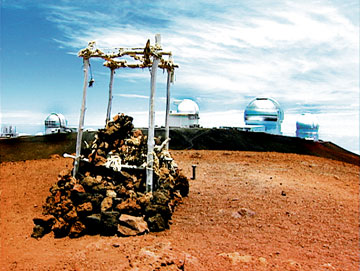
COURTESY OF WWW.NAMAKA.COM
This 2002 photo shows the Hawaiian altar at the summit of Mauna Kea, which holds the personal effects of two Hawaii soldiers killed in Iraq. The altar was desecrated Tuesday.
|
|
Vandals strike Hawaiian altar at Mauna Kea summit
The memorial held items of 2 soldiers from Hawaii who were killed in Iraq
HILO » A Hawaiian altar at the summit of Mauna Kea used for spiritual purposes since 1997 was knocked down Tuesday by unknown vandals, according to a Big Island activist.
The altar also had been used as a resting place for personal items of two soldiers from Hawaii killed in Iraq.
"It's customary practice to place things of the deceased in high places," said Kealoha Pisciotta, who has criticized observatory expansion on Mauna Kea.
Breaking into tears, she added, "They lost their sons. It's obviously hurtful and disrespectful."
Honolulu attorney Allen Hoe, whose son Nainoa was killed by a sniper in Mosul, Iraq, last year, said he felt "blown away" by the desecration. "Talk about hateful acts," he said.
Amid the rocks of the altar, Hoe had placed a written version of his son's genealogy, his son's Army "Ranger tab," a kind of badge, and other items.
The family of the second man with items in the altar did not want to be identified.
Pisciotta said people should try to avoid anger at the desecration. "We have to remember that Mauna Kea is for peace," she said.
The altar was erected in 1997 by the Royal Order of Kamehameha "to help provide a focus of reverence," Pisciotta said.
It was a time when old plans for astronomy on Mauna Kea were ending, new plans were being proposed and some people were angered by feelings that the biological and cultural resources of the summit were mismanaged.
The Royal Order built a "lele," a wooden skeleton of an altar 6 feet high with posts in four corners, Pisciotta said. To anchor it, rocks were placed at the base, beginning an "ahu," or stone altar. More stones were added by visitors over time.
The lele stands barely a yard from a U.S. Geological Survey marker showing the true summit of the mountain, which is a few hundred feet from the closest observatories.
The day after it was built, 115-mph winds raked the summit, but the lele was undamaged, Pisciotta said.
On Tuesday a patrolling Mauna Kea ranger saw the lele still standing in the morning but knocked down in the afternoon, said Bill Stormont, director of the Office of Mauna Kea Management of the University of Hawaii at Hilo.
A machete might have been used, Pisciotta said. "It looks like it was hacked down," she said.
Stormont said he has five rangers under his command, but only two at a time are on duty and they have no enforcement powers. A bill to give them that power failed in the Legislature last year and is pending this year, he said.
There might be no law to enforce, since the lele is not a historic structure, and there might be no law protecting a new religious structure, Stormont suggested.
Rangers count cars going to the summit area but do not take license plate numbers, he said.
The Mauna Kea management structure calls for Stormont to be guided by a group of Hawaiians called the Kahu Ku Mauna Advisory Council.
Some members feel that a lele is traditionally built to serve for a specific purpose and time and then should be removed, he said. After more than eight years, some felt that the time to remove it had come, he said. But there is no information on who knocked it down.
Hoe said the nature of the structure has changed with time from a temporary lele to a permanent ahu. It "absolutely" has a right to remain, he said.
"A lot of other Hawaiians have adopted that as a kind of special place for tributes to their ancestors," he said. "It is the highest point of our cultural being."

